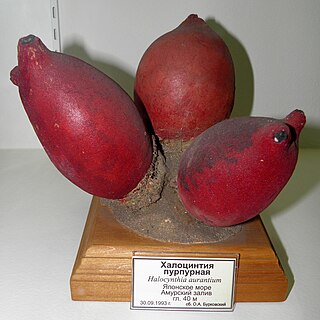Related Research Articles

Halocynthia aurantium, commonly known as the sea peach, is a species of tunicate in the order Stolidobranchia. Sea peaches are commonly found in the northern Pacific ocean, ranging from the Arctic Sea south to Puget Sound, and most common in the Bering Sea at a depth of 40 to 100 metres. The sea peach is typically barrel shaped, growing to a height of 18 centimetres, and its body is attached directly to the substrate. It is usually red or orange with a smooth or wrinkled tunic. There are two siphons at the top. The sea peach is preyed upon by crabs and sea stars.

Halocyntia papillosa, also known as the red sea squirt is a sea peach or sea squirt, a species of tunicate.

Halocidin is an antimicrobial peptide isolated from Halocynthia aurantium.
Aeromicrobium halocynthiae is a Gram-positive, non-spore-forming, aerobic, rod-shaped and non-motile bacterium from the genus of Aeromicrobium which has been isolated from the sea pineapple from the coast of Gangneungon Korea.Aeromicrobium halocynthiae produces taurocholic acid.
Colwellia meonggei is a Gram-negative, non-spore-forming aerobic and motile bacterium from the genus of Colwellia which has been isolated from the sea squirt Halocynthia roretzi from the South sea in Korea.
Aliiroseovarius halocynthiae is a Gram-negative and motile bacterium from the genus of Aliiroseovarius which has been isolated from the sea squirt Halocynthia roretzi from the South Sea in Korea.
Ascidiaceihabitans is a Gram-negative and aerobic genus of bacteria from the family of Rhodobacteraceae with one known species. Ascidiaceihabitans donghaensis has been isolated from the sea squirt Halocynthia aurantium from the Sea of Japan in Korea.
Halocynthiibacter is a genus of bacteria in the family Rhodobacteraceae.
Halocynthiibacter namhaensis is a Gram-negative, rod-shaped and non-motile bacterium from the genus of Halocynthiibacter which has been isolated from the sea squirt Halocynthia roretzi from the South Sea in Korea.
Hasllibacter is a Gram-negative and aerobic genus of bacteria from the family of Rhodobacteraceae with one known species. Hasllibacter halocynthiae has been isolated from a Sea pineapple from Gangneung in Korea.
Litoreibacter albidus is a Gram-negative, strictly aerobic and non-motile bacterium from the genus of Litoreibacter which has been isolated from the sea snail Umbonium costatum from the Sea of Japan.
Litoreibacter arenae is a Gram-negative, and short rod-shaped bacterium from the genus of Litoreibacter which has been isolated from sand from the Homi Cape in Korea.
Litoreibacter halocynthiae is a Gram-negative and non-motile bacterium from the genus of Litoreibacter which has been isolated from the sea squirt Halocynthia roretzi from the South Sea in Korea.
Litoreibacter janthinus is a Gram-negative, strictly aerobic and non-motile bacterium from the genus of Litoreibacter which has been isolated from sediments from the Sea of Japan.
Litoreibacter meonggei is a Gram-negative and non-motile bacterium from the genus of Litoreibacter which has been isolated from the sea squirt Halocynthia roretzi from the South Sea in Korea.
Litoreibacter ponti is a Gram-negative, aerobic and non-motile bacterium from the genus of Litoreibacter which has been isolated from seawater from the Geoje Island in Korea.
Pseudopelagicola is a Gram-negative and aerobic genus of bacteria from the family of Rhodobacteraceae with one known species. Pseudopelagicola gijangensis has been isolated from a sea squirt from the South Sea in Korea.
Tenacibaculum ascidiaceicola is a Gram-negative and non-spore-forming bacterium from the genus of Tenacibaculum which has been isolated from the sea squirt Halocynthia aurantium.
Paraglaciecola mesophila is a Gram-negative, slightly halophilic, heterotrophic and motile bacterium from the genus of Paraglaciecola which has been isolated from the liquor of an ascidian from the Troista Bay in Russia.
Halocynthia igaboja, commonly known as the sea hedgehog, the bristly tunicate or spiny sea squirt, is a species of tunicate in the family Pyuridae. It is native to the northeastern Pacific Ocean. This species was first described in 1906 by the Japanese marine biologist Asajiro Oka, who gave it the name Cynthia ritteri. It was later transferred to the genus Halocynthia.
References
- 1 2 Parte, A.C. "Litoreibacter". LPSN .
- 1 2 "Litoreibacter ascidiaceicola". www.uniprot.org.
- ↑ "Details: DSM-100566". www.dsmz.de.
- ↑ Kim, YO; Park, S; Nam, BH; Park, JM; Kim, DG; Yoon, JH (August 2014). "Litoreibacter ascidiaceicola sp. nov., isolated from the golden sea squirt Halocynthia aurantium". International Journal of Systematic and Evolutionary Microbiology. 64 (Pt 8): 2545–50. doi: 10.1099/ijs.0.064196-0 . PMID 24812362.
| This Rhodobacterales article is a stub. You can help Wikipedia by expanding it. |